Hospitality Business Toolkit Report: Financial, HR, & Operations
VerifiedAdded on 2020/11/12
|14
|3693
|165
Report
AI Summary
This report, focusing on the hospitality business toolkit, provides a comprehensive analysis of financial performance, human resource management, and operational aspects within the hospitality industry, specifically using Lavish Stay Hotels as a case study. The report delves into the principles of managing financial records, including the application of double-entry bookkeeping and the compilation of trial balances. It examines the HR life cycle, emphasizing talent acquisition, performance management, and strategies for employee retention and development. Furthermore, the report explores various functional roles within the hospitality sector, communication methods, and the importance of integrating different functions to strengthen the value chain. The report also includes detailed examples such as how Lavish Stay Hotels uses advertisements, interviews, induction, performance reviews, and exit interviews to manage their human resources and retain employees. The report concludes with the application of a performance management plan to address and overcome staff issues, emphasizing the alignment of talent management with the company's strategic goals. This report is designed to provide insights into the key components of the hospitality business toolkit and provide students with valuable information.
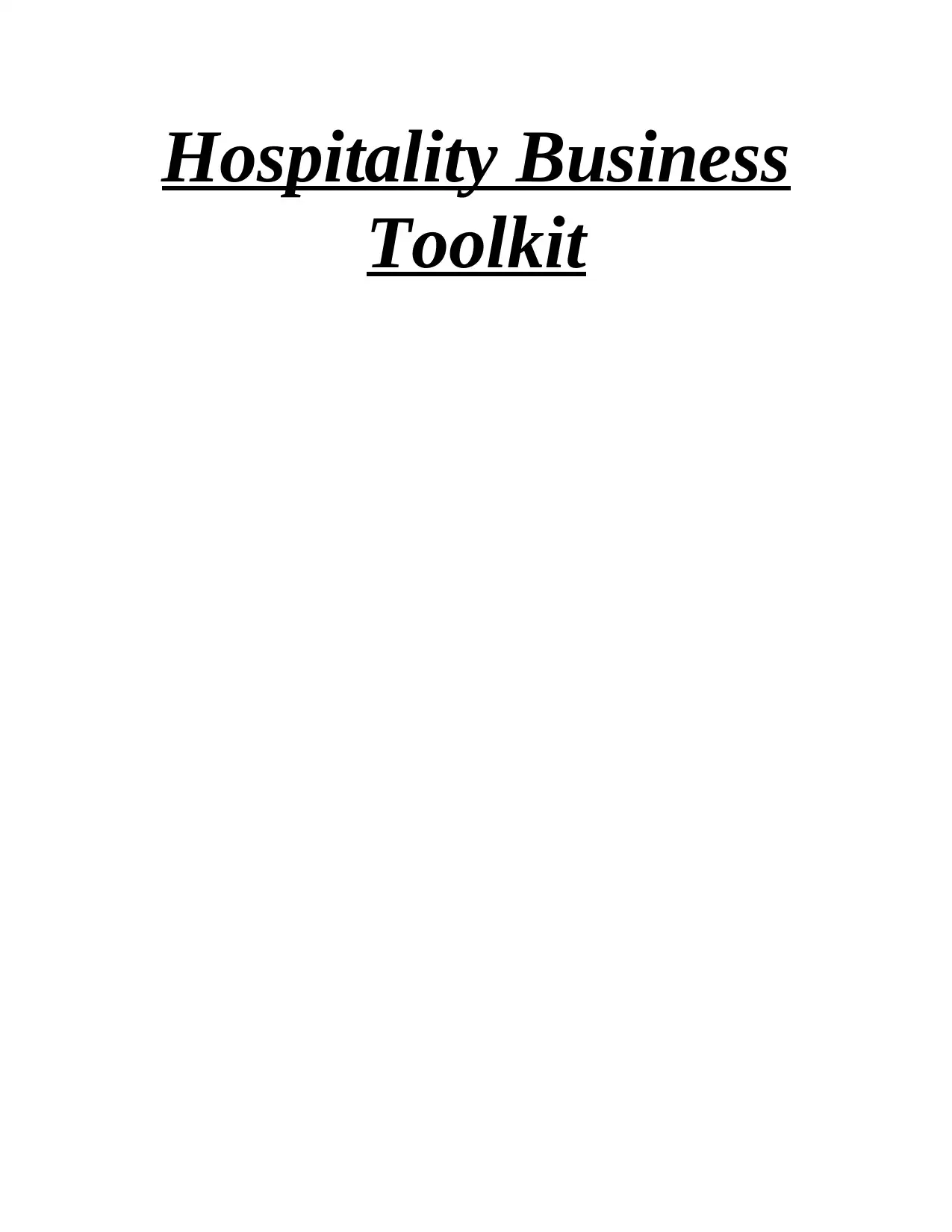
Hospitality Business
Toolkit
Toolkit
Paraphrase This Document
Need a fresh take? Get an instant paraphrase of this document with our AI Paraphraser
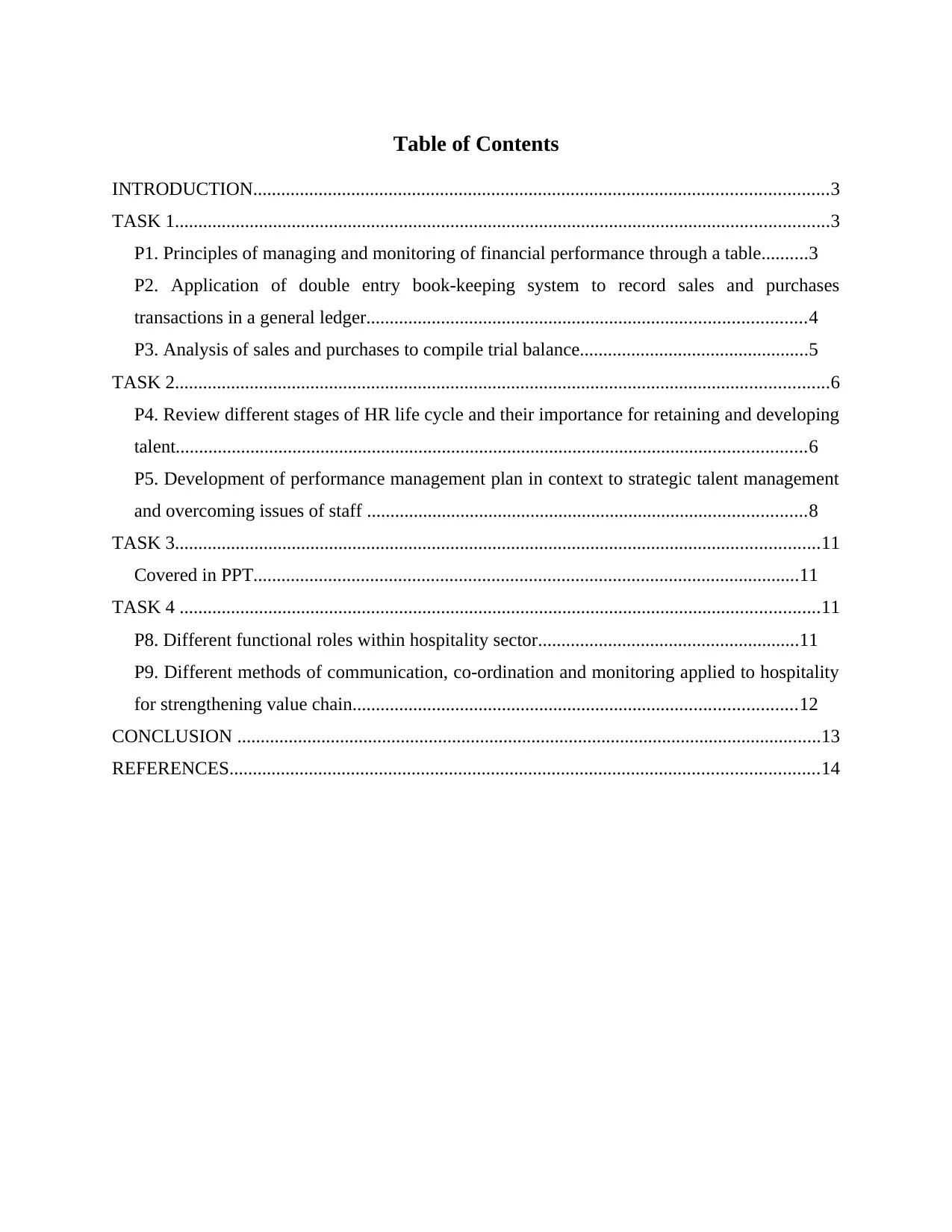
Table of Contents
INTRODUCTION...........................................................................................................................3
TASK 1............................................................................................................................................3
P1. Principles of managing and monitoring of financial performance through a table..........3
P2. Application of double entry book-keeping system to record sales and purchases
transactions in a general ledger..............................................................................................4
P3. Analysis of sales and purchases to compile trial balance.................................................5
TASK 2............................................................................................................................................6
P4. Review different stages of HR life cycle and their importance for retaining and developing
talent.......................................................................................................................................6
P5. Development of performance management plan in context to strategic talent management
and overcoming issues of staff ..............................................................................................8
TASK 3..........................................................................................................................................11
Covered in PPT.....................................................................................................................11
TASK 4 .........................................................................................................................................11
P8. Different functional roles within hospitality sector........................................................11
P9. Different methods of communication, co-ordination and monitoring applied to hospitality
for strengthening value chain...............................................................................................12
CONCLUSION .............................................................................................................................13
REFERENCES..............................................................................................................................14
INTRODUCTION...........................................................................................................................3
TASK 1............................................................................................................................................3
P1. Principles of managing and monitoring of financial performance through a table..........3
P2. Application of double entry book-keeping system to record sales and purchases
transactions in a general ledger..............................................................................................4
P3. Analysis of sales and purchases to compile trial balance.................................................5
TASK 2............................................................................................................................................6
P4. Review different stages of HR life cycle and their importance for retaining and developing
talent.......................................................................................................................................6
P5. Development of performance management plan in context to strategic talent management
and overcoming issues of staff ..............................................................................................8
TASK 3..........................................................................................................................................11
Covered in PPT.....................................................................................................................11
TASK 4 .........................................................................................................................................11
P8. Different functional roles within hospitality sector........................................................11
P9. Different methods of communication, co-ordination and monitoring applied to hospitality
for strengthening value chain...............................................................................................12
CONCLUSION .............................................................................................................................13
REFERENCES..............................................................................................................................14
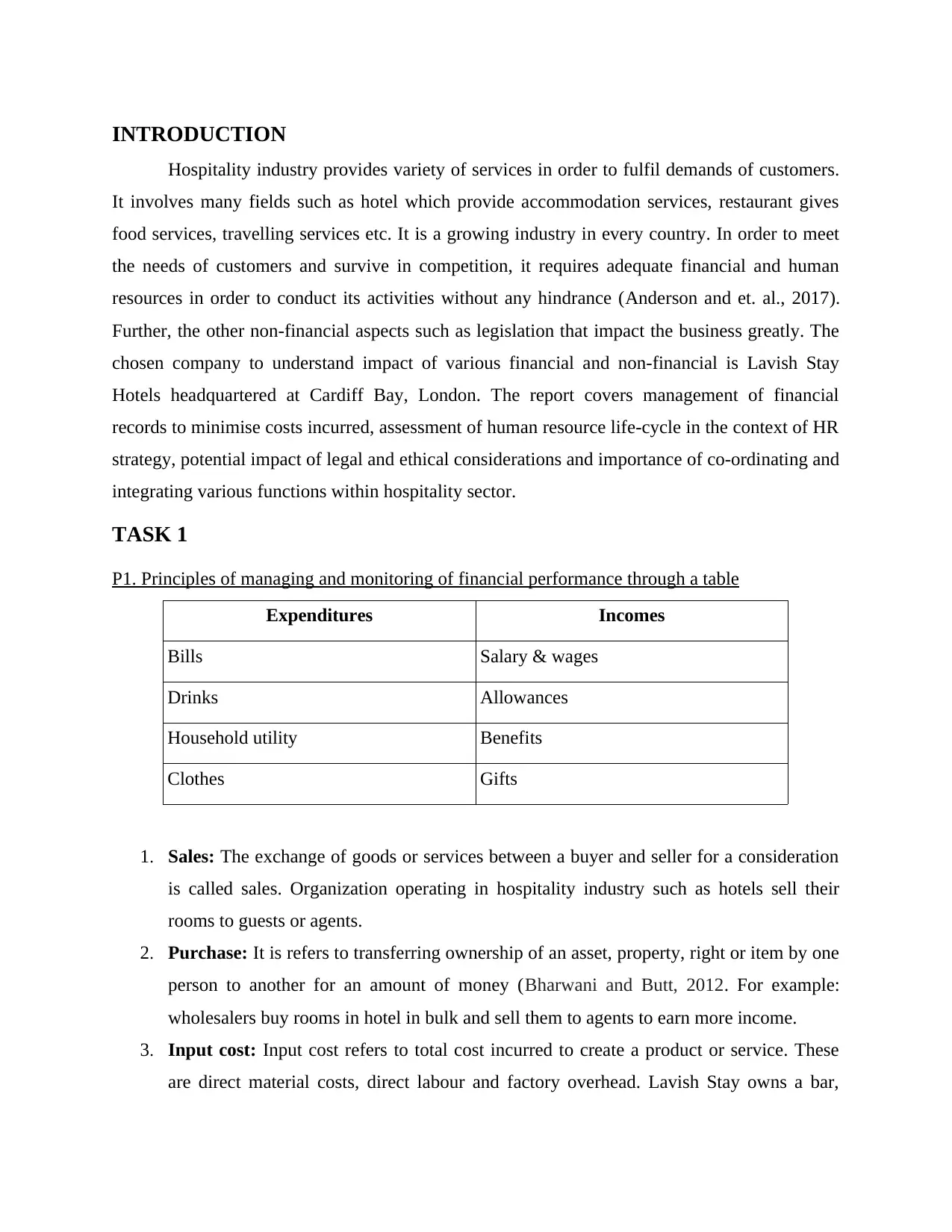
INTRODUCTION
Hospitality industry provides variety of services in order to fulfil demands of customers.
It involves many fields such as hotel which provide accommodation services, restaurant gives
food services, travelling services etc. It is a growing industry in every country. In order to meet
the needs of customers and survive in competition, it requires adequate financial and human
resources in order to conduct its activities without any hindrance (Anderson and et. al., 2017).
Further, the other non-financial aspects such as legislation that impact the business greatly. The
chosen company to understand impact of various financial and non-financial is Lavish Stay
Hotels headquartered at Cardiff Bay, London. The report covers management of financial
records to minimise costs incurred, assessment of human resource life-cycle in the context of HR
strategy, potential impact of legal and ethical considerations and importance of co-ordinating and
integrating various functions within hospitality sector.
TASK 1
P1. Principles of managing and monitoring of financial performance through a table
Expenditures Incomes
Bills Salary & wages
Drinks Allowances
Household utility Benefits
Clothes Gifts
1. Sales: The exchange of goods or services between a buyer and seller for a consideration
is called sales. Organization operating in hospitality industry such as hotels sell their
rooms to guests or agents.
2. Purchase: It is refers to transferring ownership of an asset, property, right or item by one
person to another for an amount of money (Bharwani and Butt, 2012. For example:
wholesalers buy rooms in hotel in bulk and sell them to agents to earn more income.
3. Input cost: Input cost refers to total cost incurred to create a product or service. These
are direct material costs, direct labour and factory overhead. Lavish Stay owns a bar,
Hospitality industry provides variety of services in order to fulfil demands of customers.
It involves many fields such as hotel which provide accommodation services, restaurant gives
food services, travelling services etc. It is a growing industry in every country. In order to meet
the needs of customers and survive in competition, it requires adequate financial and human
resources in order to conduct its activities without any hindrance (Anderson and et. al., 2017).
Further, the other non-financial aspects such as legislation that impact the business greatly. The
chosen company to understand impact of various financial and non-financial is Lavish Stay
Hotels headquartered at Cardiff Bay, London. The report covers management of financial
records to minimise costs incurred, assessment of human resource life-cycle in the context of HR
strategy, potential impact of legal and ethical considerations and importance of co-ordinating and
integrating various functions within hospitality sector.
TASK 1
P1. Principles of managing and monitoring of financial performance through a table
Expenditures Incomes
Bills Salary & wages
Drinks Allowances
Household utility Benefits
Clothes Gifts
1. Sales: The exchange of goods or services between a buyer and seller for a consideration
is called sales. Organization operating in hospitality industry such as hotels sell their
rooms to guests or agents.
2. Purchase: It is refers to transferring ownership of an asset, property, right or item by one
person to another for an amount of money (Bharwani and Butt, 2012. For example:
wholesalers buy rooms in hotel in bulk and sell them to agents to earn more income.
3. Input cost: Input cost refers to total cost incurred to create a product or service. These
are direct material costs, direct labour and factory overhead. Lavish Stay owns a bar,
⊘ This is a preview!⊘
Do you want full access?
Subscribe today to unlock all pages.

Trusted by 1+ million students worldwide
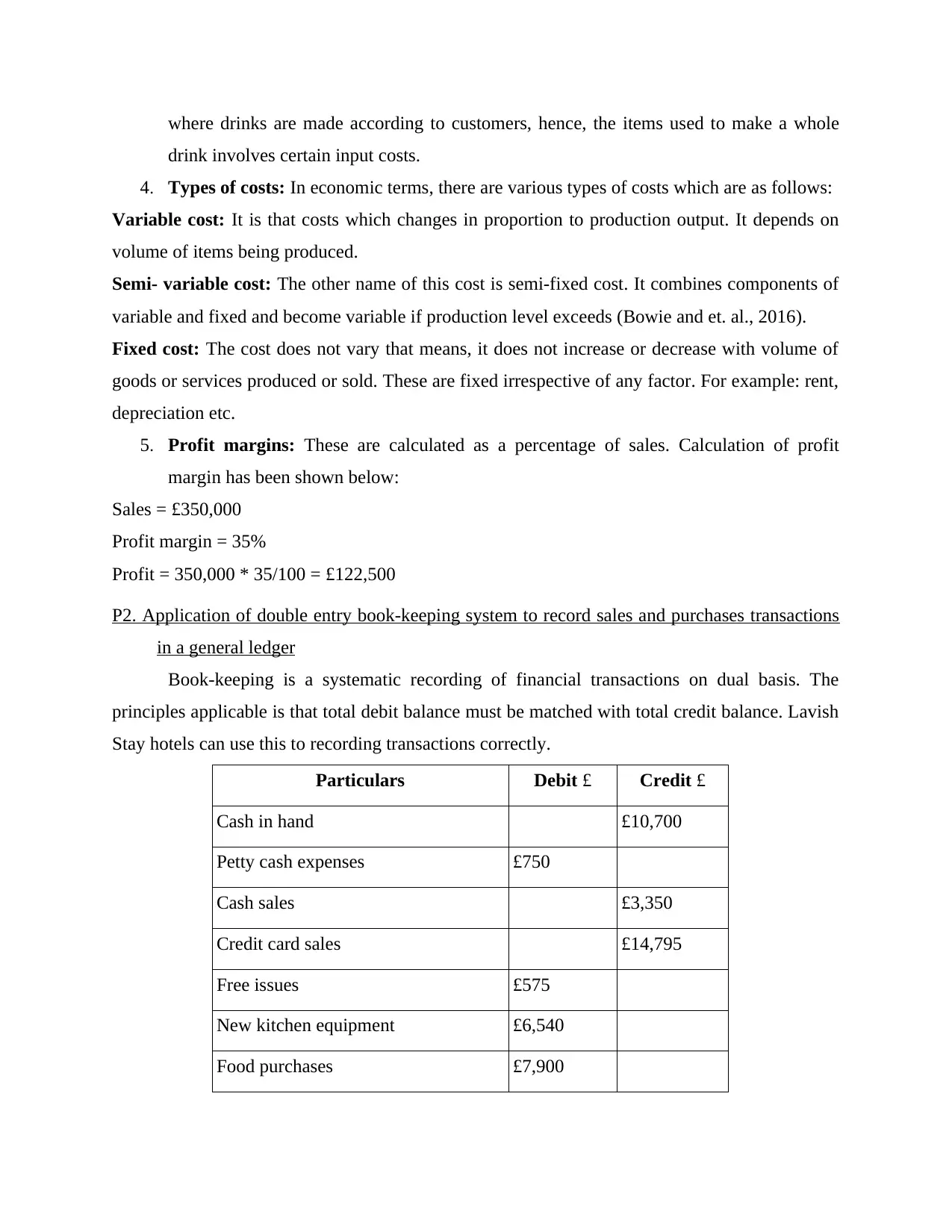
where drinks are made according to customers, hence, the items used to make a whole
drink involves certain input costs.
4. Types of costs: In economic terms, there are various types of costs which are as follows:
Variable cost: It is that costs which changes in proportion to production output. It depends on
volume of items being produced.
Semi- variable cost: The other name of this cost is semi-fixed cost. It combines components of
variable and fixed and become variable if production level exceeds (Bowie and et. al., 2016).
Fixed cost: The cost does not vary that means, it does not increase or decrease with volume of
goods or services produced or sold. These are fixed irrespective of any factor. For example: rent,
depreciation etc.
5. Profit margins: These are calculated as a percentage of sales. Calculation of profit
margin has been shown below:
Sales = £350,000
Profit margin = 35%
Profit = 350,000 * 35/100 = £122,500
P2. Application of double entry book-keeping system to record sales and purchases transactions
in a general ledger
Book-keeping is a systematic recording of financial transactions on dual basis. The
principles applicable is that total debit balance must be matched with total credit balance. Lavish
Stay hotels can use this to recording transactions correctly.
Particulars Debit £ Credit £
Cash in hand £10,700
Petty cash expenses £750
Cash sales £3,350
Credit card sales £14,795
Free issues £575
New kitchen equipment £6,540
Food purchases £7,900
drink involves certain input costs.
4. Types of costs: In economic terms, there are various types of costs which are as follows:
Variable cost: It is that costs which changes in proportion to production output. It depends on
volume of items being produced.
Semi- variable cost: The other name of this cost is semi-fixed cost. It combines components of
variable and fixed and become variable if production level exceeds (Bowie and et. al., 2016).
Fixed cost: The cost does not vary that means, it does not increase or decrease with volume of
goods or services produced or sold. These are fixed irrespective of any factor. For example: rent,
depreciation etc.
5. Profit margins: These are calculated as a percentage of sales. Calculation of profit
margin has been shown below:
Sales = £350,000
Profit margin = 35%
Profit = 350,000 * 35/100 = £122,500
P2. Application of double entry book-keeping system to record sales and purchases transactions
in a general ledger
Book-keeping is a systematic recording of financial transactions on dual basis. The
principles applicable is that total debit balance must be matched with total credit balance. Lavish
Stay hotels can use this to recording transactions correctly.
Particulars Debit £ Credit £
Cash in hand £10,700
Petty cash expenses £750
Cash sales £3,350
Credit card sales £14,795
Free issues £575
New kitchen equipment £6,540
Food purchases £7,900
Paraphrase This Document
Need a fresh take? Get an instant paraphrase of this document with our AI Paraphraser
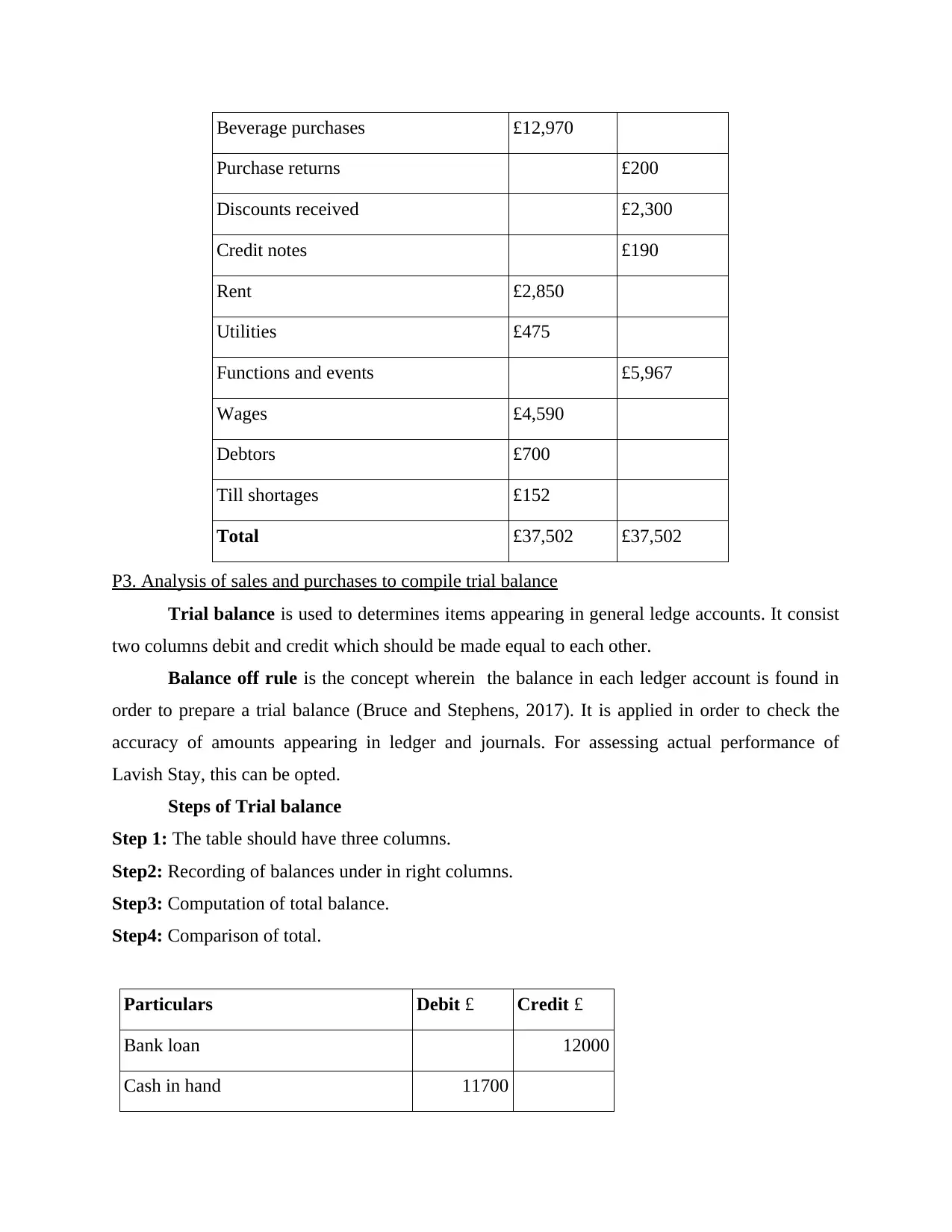
Beverage purchases £12,970
Purchase returns £200
Discounts received £2,300
Credit notes £190
Rent £2,850
Utilities £475
Functions and events £5,967
Wages £4,590
Debtors £700
Till shortages £152
Total £37,502 £37,502
P3. Analysis of sales and purchases to compile trial balance
Trial balance is used to determines items appearing in general ledge accounts. It consist
two columns debit and credit which should be made equal to each other.
Balance off rule is the concept wherein the balance in each ledger account is found in
order to prepare a trial balance (Bruce and Stephens, 2017). It is applied in order to check the
accuracy of amounts appearing in ledger and journals. For assessing actual performance of
Lavish Stay, this can be opted.
Steps of Trial balance
Step 1: The table should have three columns.
Step2: Recording of balances under in right columns.
Step3: Computation of total balance.
Step4: Comparison of total.
Particulars Debit £ Credit £
Bank loan 12000
Cash in hand 11700
Purchase returns £200
Discounts received £2,300
Credit notes £190
Rent £2,850
Utilities £475
Functions and events £5,967
Wages £4,590
Debtors £700
Till shortages £152
Total £37,502 £37,502
P3. Analysis of sales and purchases to compile trial balance
Trial balance is used to determines items appearing in general ledge accounts. It consist
two columns debit and credit which should be made equal to each other.
Balance off rule is the concept wherein the balance in each ledger account is found in
order to prepare a trial balance (Bruce and Stephens, 2017). It is applied in order to check the
accuracy of amounts appearing in ledger and journals. For assessing actual performance of
Lavish Stay, this can be opted.
Steps of Trial balance
Step 1: The table should have three columns.
Step2: Recording of balances under in right columns.
Step3: Computation of total balance.
Step4: Comparison of total.
Particulars Debit £ Credit £
Bank loan 12000
Cash in hand 11700
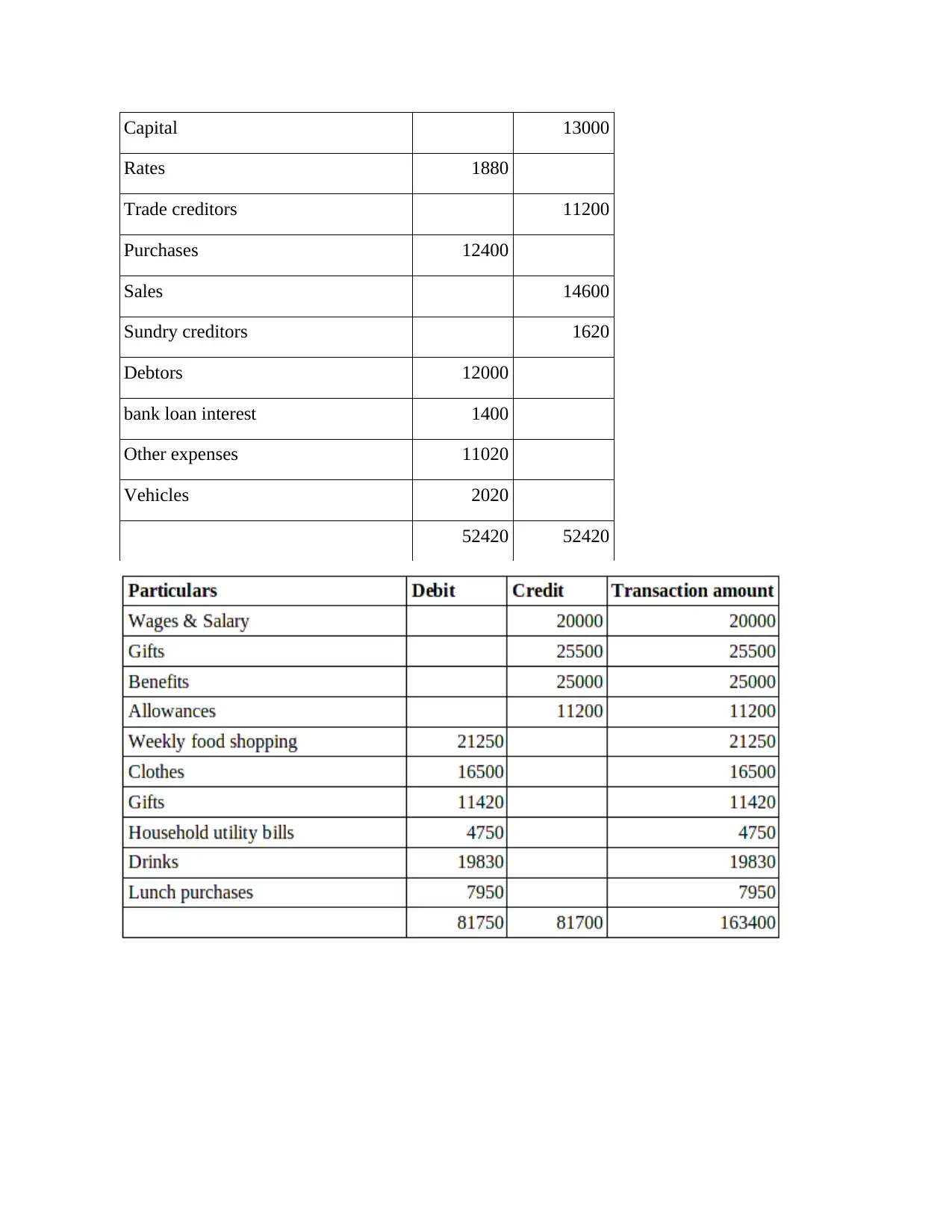
Capital 13000
Rates 1880
Trade creditors 11200
Purchases 12400
Sales 14600
Sundry creditors 1620
Debtors 12000
bank loan interest 1400
Other expenses 11020
Vehicles 2020
52420 52420
Rates 1880
Trade creditors 11200
Purchases 12400
Sales 14600
Sundry creditors 1620
Debtors 12000
bank loan interest 1400
Other expenses 11020
Vehicles 2020
52420 52420
⊘ This is a preview!⊘
Do you want full access?
Subscribe today to unlock all pages.

Trusted by 1+ million students worldwide
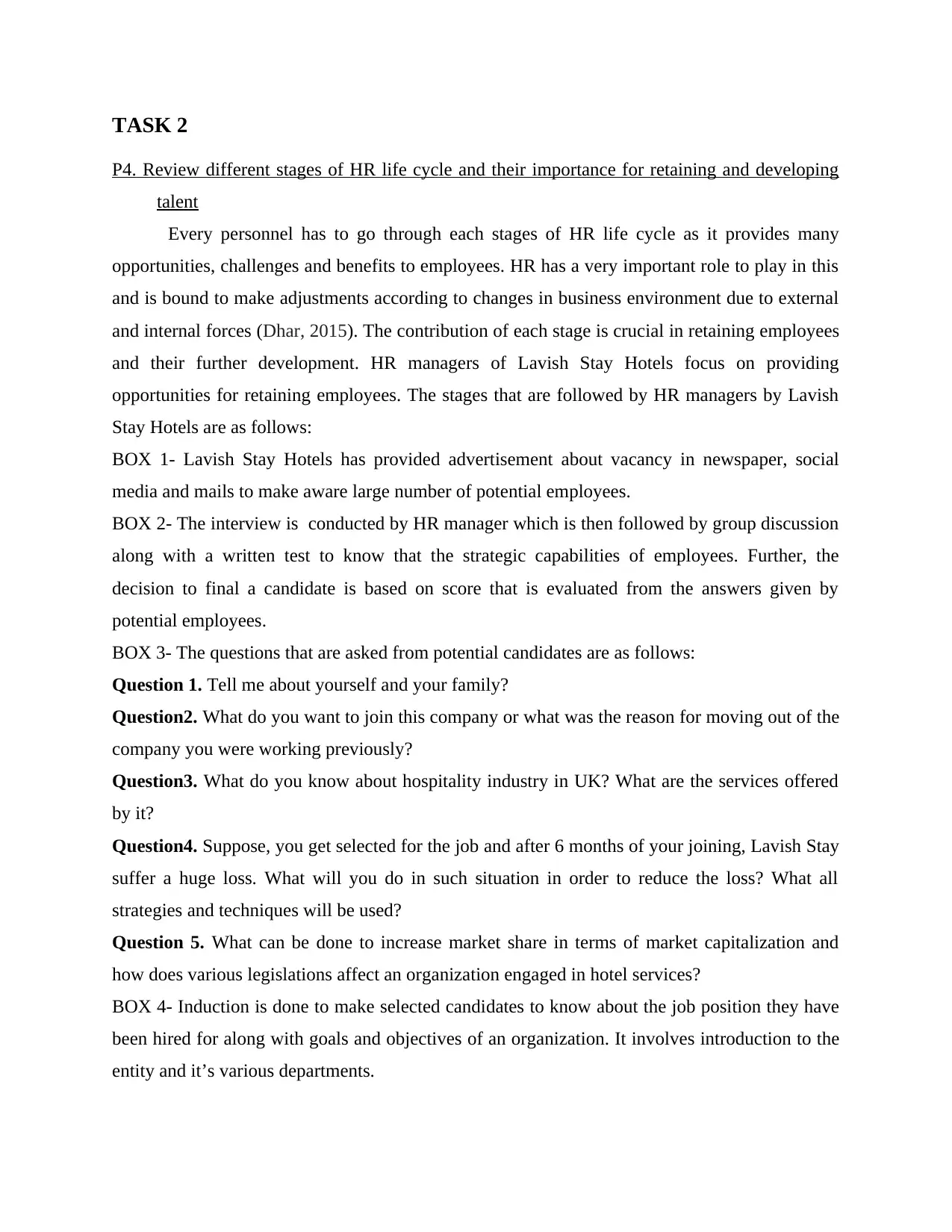
TASK 2
P4. Review different stages of HR life cycle and their importance for retaining and developing
talent
Every personnel has to go through each stages of HR life cycle as it provides many
opportunities, challenges and benefits to employees. HR has a very important role to play in this
and is bound to make adjustments according to changes in business environment due to external
and internal forces (Dhar, 2015). The contribution of each stage is crucial in retaining employees
and their further development. HR managers of Lavish Stay Hotels focus on providing
opportunities for retaining employees. The stages that are followed by HR managers by Lavish
Stay Hotels are as follows:
BOX 1- Lavish Stay Hotels has provided advertisement about vacancy in newspaper, social
media and mails to make aware large number of potential employees.
BOX 2- The interview is conducted by HR manager which is then followed by group discussion
along with a written test to know that the strategic capabilities of employees. Further, the
decision to final a candidate is based on score that is evaluated from the answers given by
potential employees.
BOX 3- The questions that are asked from potential candidates are as follows:
Question 1. Tell me about yourself and your family?
Question2. What do you want to join this company or what was the reason for moving out of the
company you were working previously?
Question3. What do you know about hospitality industry in UK? What are the services offered
by it?
Question4. Suppose, you get selected for the job and after 6 months of your joining, Lavish Stay
suffer a huge loss. What will you do in such situation in order to reduce the loss? What all
strategies and techniques will be used?
Question 5. What can be done to increase market share in terms of market capitalization and
how does various legislations affect an organization engaged in hotel services?
BOX 4- Induction is done to make selected candidates to know about the job position they have
been hired for along with goals and objectives of an organization. It involves introduction to the
entity and it’s various departments.
P4. Review different stages of HR life cycle and their importance for retaining and developing
talent
Every personnel has to go through each stages of HR life cycle as it provides many
opportunities, challenges and benefits to employees. HR has a very important role to play in this
and is bound to make adjustments according to changes in business environment due to external
and internal forces (Dhar, 2015). The contribution of each stage is crucial in retaining employees
and their further development. HR managers of Lavish Stay Hotels focus on providing
opportunities for retaining employees. The stages that are followed by HR managers by Lavish
Stay Hotels are as follows:
BOX 1- Lavish Stay Hotels has provided advertisement about vacancy in newspaper, social
media and mails to make aware large number of potential employees.
BOX 2- The interview is conducted by HR manager which is then followed by group discussion
along with a written test to know that the strategic capabilities of employees. Further, the
decision to final a candidate is based on score that is evaluated from the answers given by
potential employees.
BOX 3- The questions that are asked from potential candidates are as follows:
Question 1. Tell me about yourself and your family?
Question2. What do you want to join this company or what was the reason for moving out of the
company you were working previously?
Question3. What do you know about hospitality industry in UK? What are the services offered
by it?
Question4. Suppose, you get selected for the job and after 6 months of your joining, Lavish Stay
suffer a huge loss. What will you do in such situation in order to reduce the loss? What all
strategies and techniques will be used?
Question 5. What can be done to increase market share in terms of market capitalization and
how does various legislations affect an organization engaged in hotel services?
BOX 4- Induction is done to make selected candidates to know about the job position they have
been hired for along with goals and objectives of an organization. It involves introduction to the
entity and it’s various departments.
Paraphrase This Document
Need a fresh take? Get an instant paraphrase of this document with our AI Paraphraser
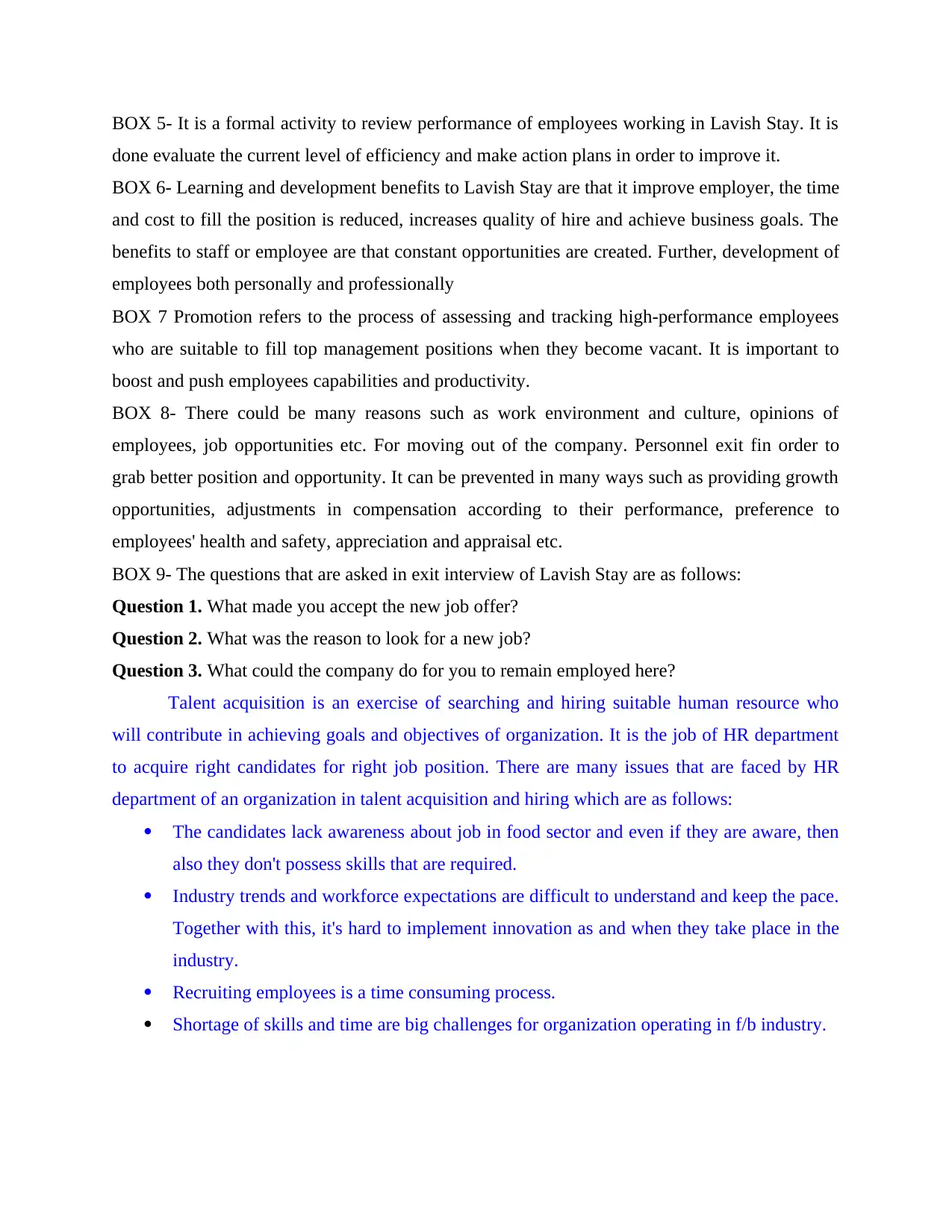
BOX 5- It is a formal activity to review performance of employees working in Lavish Stay. It is
done evaluate the current level of efficiency and make action plans in order to improve it.
BOX 6- Learning and development benefits to Lavish Stay are that it improve employer, the time
and cost to fill the position is reduced, increases quality of hire and achieve business goals. The
benefits to staff or employee are that constant opportunities are created. Further, development of
employees both personally and professionally
BOX 7 Promotion refers to the process of assessing and tracking high-performance employees
who are suitable to fill top management positions when they become vacant. It is important to
boost and push employees capabilities and productivity.
BOX 8- There could be many reasons such as work environment and culture, opinions of
employees, job opportunities etc. For moving out of the company. Personnel exit fin order to
grab better position and opportunity. It can be prevented in many ways such as providing growth
opportunities, adjustments in compensation according to their performance, preference to
employees' health and safety, appreciation and appraisal etc.
BOX 9- The questions that are asked in exit interview of Lavish Stay are as follows:
Question 1. What made you accept the new job offer?
Question 2. What was the reason to look for a new job?
Question 3. What could the company do for you to remain employed here?
Talent acquisition is an exercise of searching and hiring suitable human resource who
will contribute in achieving goals and objectives of organization. It is the job of HR department
to acquire right candidates for right job position. There are many issues that are faced by HR
department of an organization in talent acquisition and hiring which are as follows:
The candidates lack awareness about job in food sector and even if they are aware, then
also they don't possess skills that are required.
Industry trends and workforce expectations are difficult to understand and keep the pace.
Together with this, it's hard to implement innovation as and when they take place in the
industry.
Recruiting employees is a time consuming process.
Shortage of skills and time are big challenges for organization operating in f/b industry.
done evaluate the current level of efficiency and make action plans in order to improve it.
BOX 6- Learning and development benefits to Lavish Stay are that it improve employer, the time
and cost to fill the position is reduced, increases quality of hire and achieve business goals. The
benefits to staff or employee are that constant opportunities are created. Further, development of
employees both personally and professionally
BOX 7 Promotion refers to the process of assessing and tracking high-performance employees
who are suitable to fill top management positions when they become vacant. It is important to
boost and push employees capabilities and productivity.
BOX 8- There could be many reasons such as work environment and culture, opinions of
employees, job opportunities etc. For moving out of the company. Personnel exit fin order to
grab better position and opportunity. It can be prevented in many ways such as providing growth
opportunities, adjustments in compensation according to their performance, preference to
employees' health and safety, appreciation and appraisal etc.
BOX 9- The questions that are asked in exit interview of Lavish Stay are as follows:
Question 1. What made you accept the new job offer?
Question 2. What was the reason to look for a new job?
Question 3. What could the company do for you to remain employed here?
Talent acquisition is an exercise of searching and hiring suitable human resource who
will contribute in achieving goals and objectives of organization. It is the job of HR department
to acquire right candidates for right job position. There are many issues that are faced by HR
department of an organization in talent acquisition and hiring which are as follows:
The candidates lack awareness about job in food sector and even if they are aware, then
also they don't possess skills that are required.
Industry trends and workforce expectations are difficult to understand and keep the pace.
Together with this, it's hard to implement innovation as and when they take place in the
industry.
Recruiting employees is a time consuming process.
Shortage of skills and time are big challenges for organization operating in f/b industry.
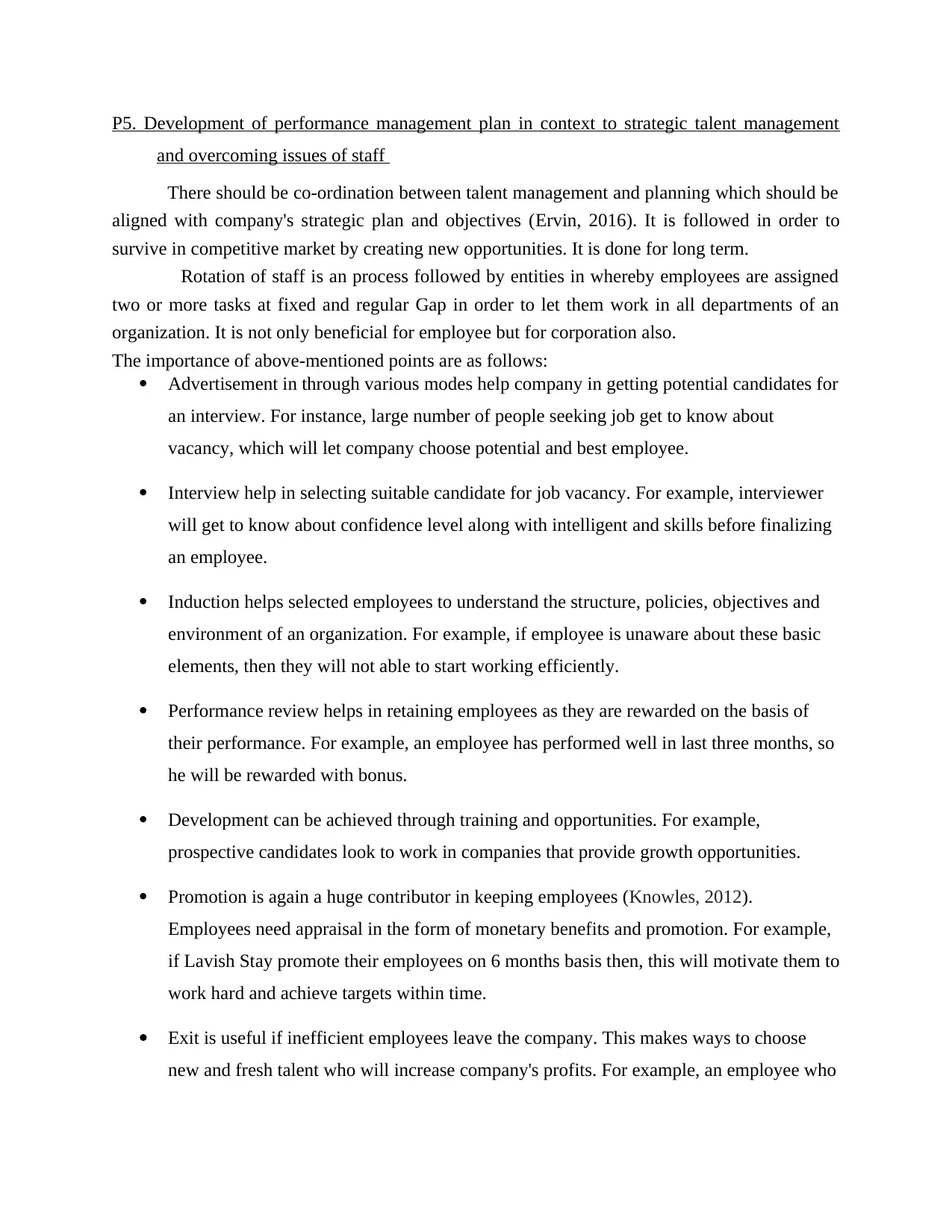
P5. Development of performance management plan in context to strategic talent management
and overcoming issues of staff
There should be co-ordination between talent management and planning which should be
aligned with company's strategic plan and objectives (Ervin, 2016). It is followed in order to
survive in competitive market by creating new opportunities. It is done for long term.
Rotation of staff is an process followed by entities in whereby employees are assigned
two or more tasks at fixed and regular Gap in order to let them work in all departments of an
organization. It is not only beneficial for employee but for corporation also.
The importance of above-mentioned points are as follows:
Advertisement in through various modes help company in getting potential candidates for
an interview. For instance, large number of people seeking job get to know about
vacancy, which will let company choose potential and best employee.
Interview help in selecting suitable candidate for job vacancy. For example, interviewer
will get to know about confidence level along with intelligent and skills before finalizing
an employee.
Induction helps selected employees to understand the structure, policies, objectives and
environment of an organization. For example, if employee is unaware about these basic
elements, then they will not able to start working efficiently.
Performance review helps in retaining employees as they are rewarded on the basis of
their performance. For example, an employee has performed well in last three months, so
he will be rewarded with bonus.
Development can be achieved through training and opportunities. For example,
prospective candidates look to work in companies that provide growth opportunities.
Promotion is again a huge contributor in keeping employees (Knowles, 2012).
Employees need appraisal in the form of monetary benefits and promotion. For example,
if Lavish Stay promote their employees on 6 months basis then, this will motivate them to
work hard and achieve targets within time.
Exit is useful if inefficient employees leave the company. This makes ways to choose
new and fresh talent who will increase company's profits. For example, an employee who
and overcoming issues of staff
There should be co-ordination between talent management and planning which should be
aligned with company's strategic plan and objectives (Ervin, 2016). It is followed in order to
survive in competitive market by creating new opportunities. It is done for long term.
Rotation of staff is an process followed by entities in whereby employees are assigned
two or more tasks at fixed and regular Gap in order to let them work in all departments of an
organization. It is not only beneficial for employee but for corporation also.
The importance of above-mentioned points are as follows:
Advertisement in through various modes help company in getting potential candidates for
an interview. For instance, large number of people seeking job get to know about
vacancy, which will let company choose potential and best employee.
Interview help in selecting suitable candidate for job vacancy. For example, interviewer
will get to know about confidence level along with intelligent and skills before finalizing
an employee.
Induction helps selected employees to understand the structure, policies, objectives and
environment of an organization. For example, if employee is unaware about these basic
elements, then they will not able to start working efficiently.
Performance review helps in retaining employees as they are rewarded on the basis of
their performance. For example, an employee has performed well in last three months, so
he will be rewarded with bonus.
Development can be achieved through training and opportunities. For example,
prospective candidates look to work in companies that provide growth opportunities.
Promotion is again a huge contributor in keeping employees (Knowles, 2012).
Employees need appraisal in the form of monetary benefits and promotion. For example,
if Lavish Stay promote their employees on 6 months basis then, this will motivate them to
work hard and achieve targets within time.
Exit is useful if inefficient employees leave the company. This makes ways to choose
new and fresh talent who will increase company's profits. For example, an employee who
⊘ This is a preview!⊘
Do you want full access?
Subscribe today to unlock all pages.

Trusted by 1+ million students worldwide
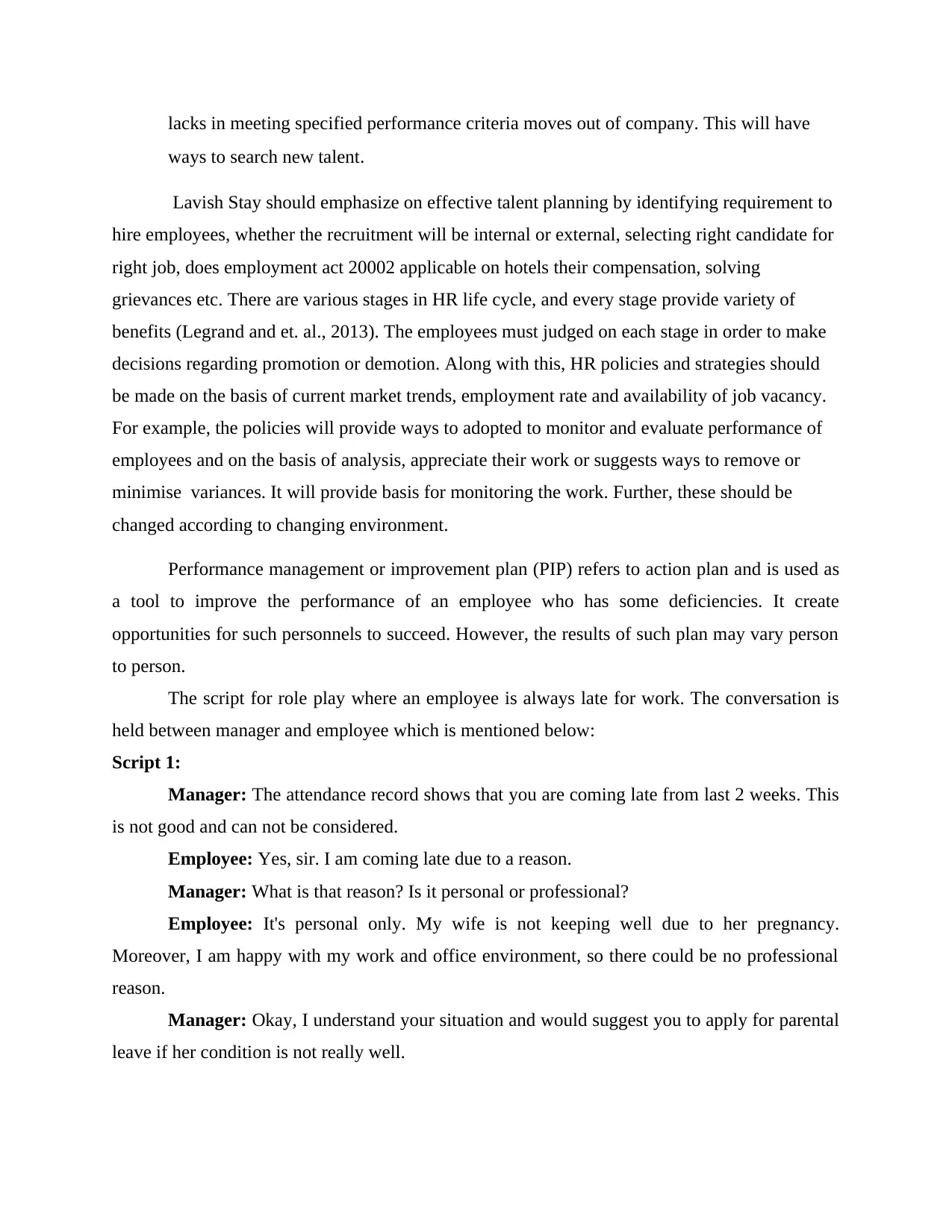
lacks in meeting specified performance criteria moves out of company. This will have
ways to search new talent.
Lavish Stay should emphasize on effective talent planning by identifying requirement to
hire employees, whether the recruitment will be internal or external, selecting right candidate for
right job, does employment act 20002 applicable on hotels their compensation, solving
grievances etc. There are various stages in HR life cycle, and every stage provide variety of
benefits (Legrand and et. al., 2013). The employees must judged on each stage in order to make
decisions regarding promotion or demotion. Along with this, HR policies and strategies should
be made on the basis of current market trends, employment rate and availability of job vacancy.
For example, the policies will provide ways to adopted to monitor and evaluate performance of
employees and on the basis of analysis, appreciate their work or suggests ways to remove or
minimise variances. It will provide basis for monitoring the work. Further, these should be
changed according to changing environment.
Performance management or improvement plan (PIP) refers to action plan and is used as
a tool to improve the performance of an employee who has some deficiencies. It create
opportunities for such personnels to succeed. However, the results of such plan may vary person
to person.
The script for role play where an employee is always late for work. The conversation is
held between manager and employee which is mentioned below:
Script 1:
Manager: The attendance record shows that you are coming late from last 2 weeks. This
is not good and can not be considered.
Employee: Yes, sir. I am coming late due to a reason.
Manager: What is that reason? Is it personal or professional?
Employee: It's personal only. My wife is not keeping well due to her pregnancy.
Moreover, I am happy with my work and office environment, so there could be no professional
reason.
Manager: Okay, I understand your situation and would suggest you to apply for parental
leave if her condition is not really well.
ways to search new talent.
Lavish Stay should emphasize on effective talent planning by identifying requirement to
hire employees, whether the recruitment will be internal or external, selecting right candidate for
right job, does employment act 20002 applicable on hotels their compensation, solving
grievances etc. There are various stages in HR life cycle, and every stage provide variety of
benefits (Legrand and et. al., 2013). The employees must judged on each stage in order to make
decisions regarding promotion or demotion. Along with this, HR policies and strategies should
be made on the basis of current market trends, employment rate and availability of job vacancy.
For example, the policies will provide ways to adopted to monitor and evaluate performance of
employees and on the basis of analysis, appreciate their work or suggests ways to remove or
minimise variances. It will provide basis for monitoring the work. Further, these should be
changed according to changing environment.
Performance management or improvement plan (PIP) refers to action plan and is used as
a tool to improve the performance of an employee who has some deficiencies. It create
opportunities for such personnels to succeed. However, the results of such plan may vary person
to person.
The script for role play where an employee is always late for work. The conversation is
held between manager and employee which is mentioned below:
Script 1:
Manager: The attendance record shows that you are coming late from last 2 weeks. This
is not good and can not be considered.
Employee: Yes, sir. I am coming late due to a reason.
Manager: What is that reason? Is it personal or professional?
Employee: It's personal only. My wife is not keeping well due to her pregnancy.
Moreover, I am happy with my work and office environment, so there could be no professional
reason.
Manager: Okay, I understand your situation and would suggest you to apply for parental
leave if her condition is not really well.
Paraphrase This Document
Need a fresh take? Get an instant paraphrase of this document with our AI Paraphraser
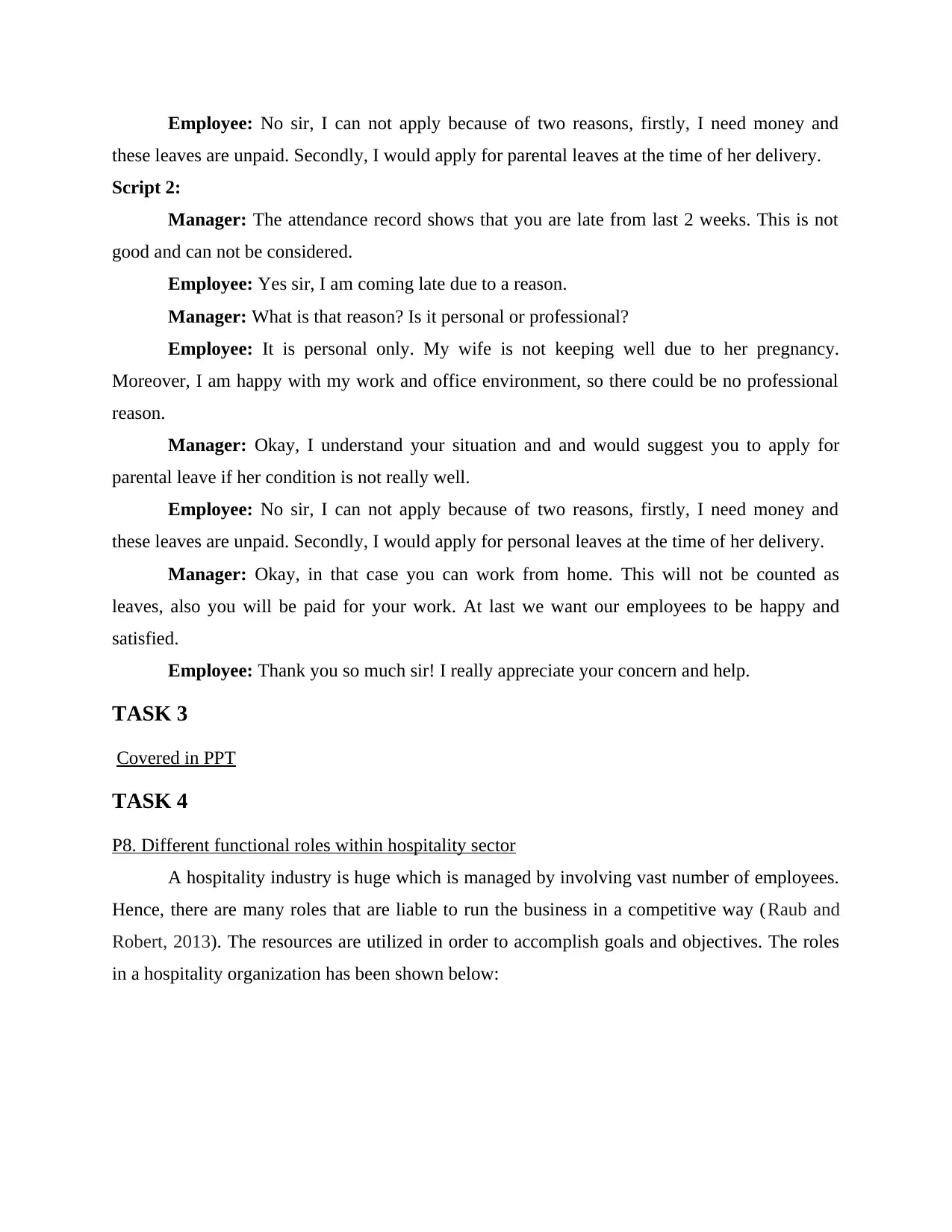
Employee: No sir, I can not apply because of two reasons, firstly, I need money and
these leaves are unpaid. Secondly, I would apply for parental leaves at the time of her delivery.
Script 2:
Manager: The attendance record shows that you are late from last 2 weeks. This is not
good and can not be considered.
Employee: Yes sir, I am coming late due to a reason.
Manager: What is that reason? Is it personal or professional?
Employee: It is personal only. My wife is not keeping well due to her pregnancy.
Moreover, I am happy with my work and office environment, so there could be no professional
reason.
Manager: Okay, I understand your situation and and would suggest you to apply for
parental leave if her condition is not really well.
Employee: No sir, I can not apply because of two reasons, firstly, I need money and
these leaves are unpaid. Secondly, I would apply for personal leaves at the time of her delivery.
Manager: Okay, in that case you can work from home. This will not be counted as
leaves, also you will be paid for your work. At last we want our employees to be happy and
satisfied.
Employee: Thank you so much sir! I really appreciate your concern and help.
TASK 3
Covered in PPT
TASK 4
P8. Different functional roles within hospitality sector
A hospitality industry is huge which is managed by involving vast number of employees.
Hence, there are many roles that are liable to run the business in a competitive way (Raub and
Robert, 2013). The resources are utilized in order to accomplish goals and objectives. The roles
in a hospitality organization has been shown below:
these leaves are unpaid. Secondly, I would apply for parental leaves at the time of her delivery.
Script 2:
Manager: The attendance record shows that you are late from last 2 weeks. This is not
good and can not be considered.
Employee: Yes sir, I am coming late due to a reason.
Manager: What is that reason? Is it personal or professional?
Employee: It is personal only. My wife is not keeping well due to her pregnancy.
Moreover, I am happy with my work and office environment, so there could be no professional
reason.
Manager: Okay, I understand your situation and and would suggest you to apply for
parental leave if her condition is not really well.
Employee: No sir, I can not apply because of two reasons, firstly, I need money and
these leaves are unpaid. Secondly, I would apply for personal leaves at the time of her delivery.
Manager: Okay, in that case you can work from home. This will not be counted as
leaves, also you will be paid for your work. At last we want our employees to be happy and
satisfied.
Employee: Thank you so much sir! I really appreciate your concern and help.
TASK 3
Covered in PPT
TASK 4
P8. Different functional roles within hospitality sector
A hospitality industry is huge which is managed by involving vast number of employees.
Hence, there are many roles that are liable to run the business in a competitive way (Raub and
Robert, 2013). The resources are utilized in order to accomplish goals and objectives. The roles
in a hospitality organization has been shown below:
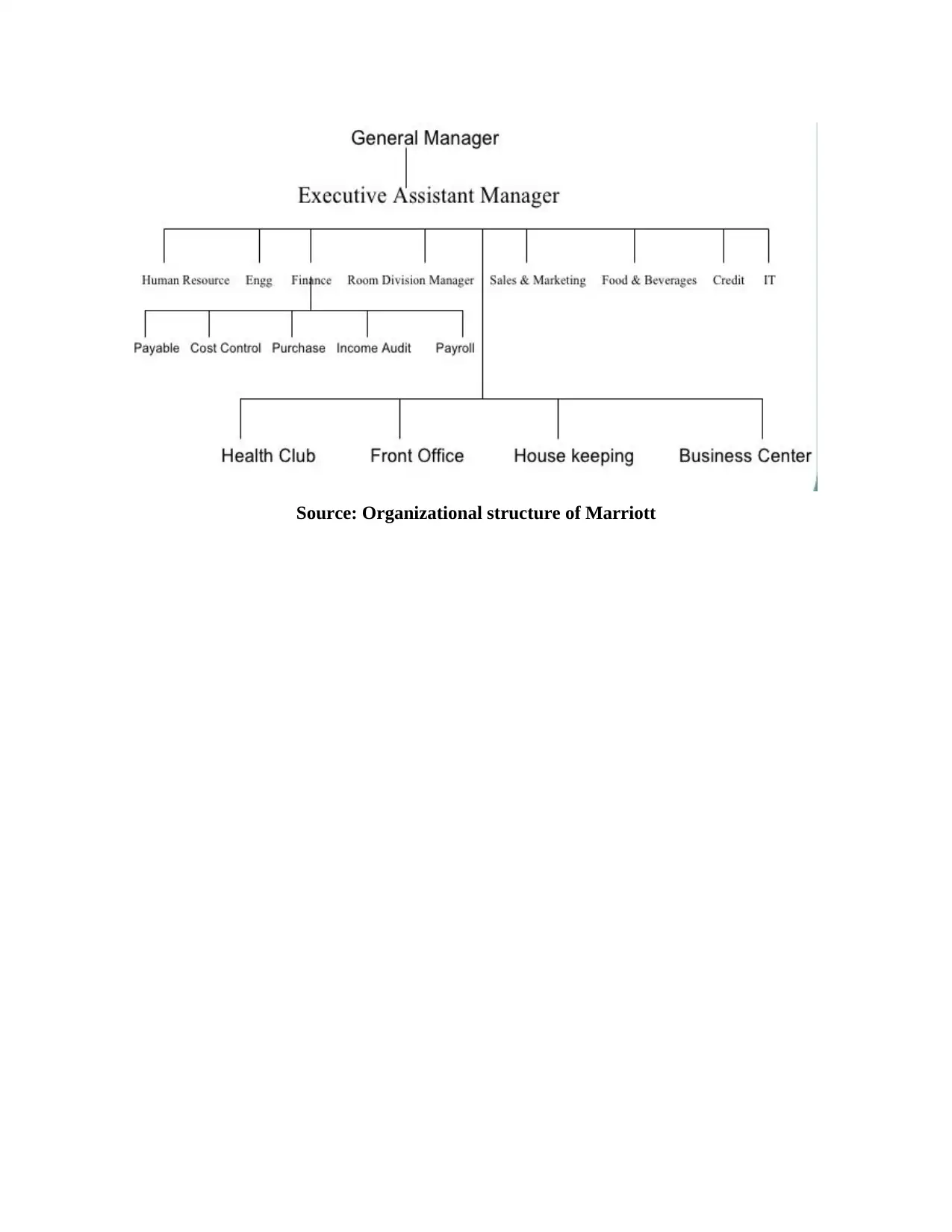
Source: Organizational structure of Marriott
⊘ This is a preview!⊘
Do you want full access?
Subscribe today to unlock all pages.

Trusted by 1+ million students worldwide
1 out of 14
Related Documents
Your All-in-One AI-Powered Toolkit for Academic Success.
+13062052269
info@desklib.com
Available 24*7 on WhatsApp / Email
![[object Object]](/_next/static/media/star-bottom.7253800d.svg)
Unlock your academic potential
Copyright © 2020–2025 A2Z Services. All Rights Reserved. Developed and managed by ZUCOL.




